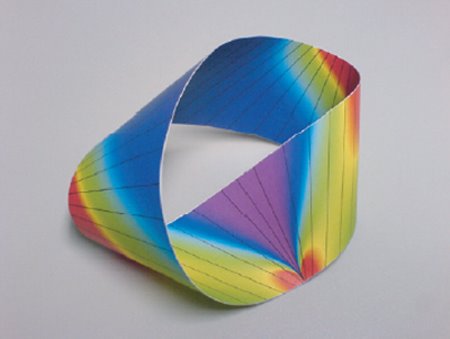 The Sun emits enormous amounts of tiny neutral particles called neutrinos (Courtesy of Wikipedia).
The Sun emits enormous amounts of tiny neutral particles called neutrinos (Courtesy of Wikipedia).The following text is an essay that I submitted to DuPont Challenge in 2007.
__________
Every second, millions of neutrinos are rushing through the period at the end of this sentence. The story of this puzzling particle begins with the process of beta decay in which a proton in a radioactive nucleus is converted into a neutron, and an electron is emitted. According to predictions, the emerging electron was expected possess specific energy quanta, but empirical evidence indicated a range of energies. In 1930, Austrian physicist Wolfgang Pauli eventually solved this problem by proposing the existence of a third and previously unknown neutral particle: the neutrino (Close et al. 2002).
Neutrinos are fundamental particles with miniscule mass, classified under the family of leptons (particles unaffected by the strong nuclear force). Since neutrinos scarcely interact with other particles or each other, detection is a daunting task (Alpert 2006). As a consequence, neutrino detectors have to be placed deep underground to filter out ‘noise’ from cosmic rays (Close et al. 2002). After its experimental verification in 1956 by physicists Cowan and Reines (Close et al. 2002), three flavours of neutrinos have been identified: the electron neutrino, the muon neutrino, and the tau neutrino. With a more firm understanding of these particles, neutrino research continues in particle physics with aims to understand the very fabric of matter. More importantly, it has given impetus to the emergence of a relatively new field: neutrino astronomy.
The Sun has always intrigued humans, as it unfailingly provides our planet with light and warmth. Though this stellar neighbour may be close, its inner workings are still not entirely understood. The fierce thermonuclear reactions that take place within the Sun emit copious amounts of neutrinos; a dazzling 60 billion of them pass through every square centimetre of the Earth’s surface per second (Close et al. 2002). American physicist Raymond Davis and his associates first detected solar neutrinos, which tend to be primarily of the electron type, in the 1970s. This led to the predictions of the solar flux of neutrinos and subsequent testing of these models in detectors such as Super Kamiokande (
As the heliophysical research on neutrinos breaks new ground, astronomers are turning to another massive source: supernovae. One of the first well-documented supernova events was on 23 February 1987, when a vibrant cosmic shower of particles arrived from the ancient explosion of Sanduleak-69202 in the Large Magellanic Cloud. In fact, two Cerenkov detectors around the world confirmed an unprecedented 19 neutrino interactions within a span of 13 seconds (Suzuki 2002, Learned 2004). This was quickly recognized to be the typical trace of events taking place at the centre of star when it collapses. It decisively confirmed theories of stellar evolution that predicted 99% of the star’s binding energy to be released as neutrinos and only the remaining 1% as visible light and other forms of radiation (Suzuki 2002). In particle astronomy, using neutrinos to track cosmic events became very popular; unlike charged cosmic rays, neutrinos are completely unaffected by strong magnetic fields in our galaxy (Close et al. 2002). Therefore, neutrino trajectories can be retraced exactly to their sources. In addition, related particles like pions and muons are affected by traversing through large bodies of matter, while “a low-energy neutrino in flight would not notice a barrier of lead 50 light-years thick.” (Learned 2004) By studying supernovae through neutrinos, a great deal about the final phases of stellar evolution can be revealed, be it the stellar collapse into a neutron star or a black hole.
In the world of physics, confirmation of the neutrino’s mass caused a total revolution. New insights on what we now call “dark matter” are emerging. “[New] models of the universe [indicate] that much more matter must be present in addition to the matter that scientists can detect. If neutrinos have mass, they could account for some of this missing matter.” (Hofstadter 2006) In response, scientists have thought of solutions such as MACHOs (massively compact halo objects) made of normal matter in invisible form. However, recent developments show that dark matter is in fact very different from normal matter. It is thought to be made of extremely light particles such as axions, neutrinos or the highly hypothetical species of WIMPs (weakly interacting massive particles) (Hawking 2001). On the other hand, neutrinos are also shedding light on a prominent theory of the universe’s origins, the Big Bang. “At about a hundredth of the second after the big bang, the temperature would have been 100 billion degrees, and the universe would have contained mostly photons, electrons, and neutrinos…and their antiparticles…” (Hawking 2001) As the study of neutrinos takes us closer to Stephen Hawking’s Grand Unified Theory, other sources of high-energy neutrinos such as collapsing galaxies, exploding galactic nuclei, black holes and matter-antimatter annihilation are being postulated.
Thorstein Veblen once commented, “The outcome of any serious research can only be to make two questions grow where only one grew before.” ("Thorstein Veblen") This is especially true in particle physics and astronomy. Though the neutrino guides us in the odyssey of comprehending the physics of the Sun, stellar collapse, even dark matter and the Big Bang, the particle itself remains elusive as ever. A researcher at
References:
Alpert, Mark. "The Neutrino Frontier." Scientific American Aug. 2006: 20-22.
Close, Frank, Michael Marten, and Christine Sutton. The Particle Odyssey: a Journey to the Heart of Matter. 2nd ed.
Hofstadter, Richard, and Schwarz, Cindy. "Neutrino." Microsoft® Student 2007 [DVD].
John G. Learned, "Neutrino astronomy", in AccessScience@McGraw-Hill, http://www.accessscience.com, DOI 10.1036/1097-8542.757595, last modified: February 3, 2004.
John N. Bahcall, "Solar neutrinos", in AccessScience@McGraw-Hill, http://www.accessscience.com, DOI 10.1036/1097-8542.633600, last modified: January 4, 2005.
"Neutrino Astronomy." Microsoft® Student 2007 [DVD].
"Thorstein Veblen." Microsoft® Student 2007 [DVD].
Yoichiro Suzuki, "Neutrino", in AccessScience@McGraw-Hill, http://www.accessscience.com, DOI 10.1036/1097-8542.450700, last modified: August 2, 2002.


No comments:
Post a Comment